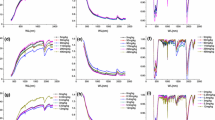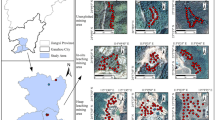Abstract
Soil contamination with heavy metals is a relatively serious issue in China. Traditional soil heavy metal survey methods cannot meet the demand for rapid and real-time large-scale area soil heavy metal surveys. We chose a typical mining area in Henan Province as the study area, collected 124 soil samples in the field and obtained their soil hyperspectral data indoors using a spectrometer. After different spectral transformations of the soil spectral curves, Pearson correlation coefficients (PCC) between them and the heavy metals Cd, Cr, Cu, and Ni were calculated, and after correlation evaluation, the best spectral transformations for each heavy metal were determined and preselected characteristic wavebands were obtained. Then the support vector machine recursive feature elimination cross-validation (SVM-RFECV) is used to select among the preselected feature wavebands to obtain the final modeled wavebands, and the Adaptive Boosting (AdaBoost), Gradient Boosting Decision Tree (GBDT), Random Forest (RF), and Partial Least Squares (PLS) methods were used to establish the inversion model. The results showed that the PCC-SVM-RFECV can effectively select characteristic wavebands with high contribution to modeling from high-dimensional data. Spectral transformations methods can improve the correlation of spectra with heavy metals. The location and quantity of characteristic wavebands for the four heavy metals were different. The accuracy of AdaBoost was significantly better than that of GBDT, RF, and PLS (i.e., Ni: \(R_{{{\text{AdaBoost}}}}^{2} = 0.735,\; R_{{{\text{GBDT}}}}^{2} = 0.679, \;R_{{{\text{RF}}}}^{2} = 0.596, \;R_{{{\text{PLS}}}}^{2} = 0.510\)). This study can provide a technical reference for the use of hyperspectral inversion models for large-scale monitoring of soil heavy metal content.









Similar content being viewed by others
References
Abdi, H., & Williams, L. J. (2013). Partial least squares methods: Partial least squares correlation and partial least square regression. Computational Toxicology., 930, 549–579.
And, T. K., & Sommer, S. (2002). Estimate of heavy metal contamination in soils after a mining accident using reflectance spectroscopy. Environment Science & Technology., 36(12), 27–42.
Balabin, R. M., & Smirnov, S. V. (2011). Variable selection in near-infrared spectroscopy: Benchmarking of feature selection methods on biodiesel data. Analytica Chimica Acta., 692, 63–72.
Bazi, Y., & Melgani, F. (2006). Toward an optimal SVM classification system for hyperspectral remote sensing images. IEEE Translation on Geoscience and Remote Sensing., 44(11), 3374–3385.
Bilgili, A. V., Akbas, F., & van Es, H. M. (2011). Combined use of hyperspectral VNIR reflectance spectroscopy and kriging to predict soil variables spatially. Precision Agriculture., 12(3), 395–420.
Breiman, L. (2001). Random forests. Machine Learning, 45(1), 5–32.
Brevik, E. C., Calzolari, C., Miller, B. A., Pereira, P., Kabala, C., Baumgarten, A., & Jordán, A. (2016). Soil mapping, classification, and pedologic modeling: History and future directions. Geoderma, 264, 256–274.
Chan, C., & Paelinckx, D. (2008). Evaluation of Random Forest and Adaboost tree-based ensemble classification and spectral band selection for ecotope mapping using airborne hyperspectral imagery. Remote Sensing of Environment., 112(6), 2999–3011.
Chen, Y., & Wu, W. (2017). Mapping mineral prospectivity using an extreme learning machine regression. Ore Geology Reviews., 80, 200–213.
Chen, N. C., Zheng, Y. J., & He, X. F. (2017). Analysis of the Report on the national general survey of soil contamination. Journal of Agro-Environment Science., 36(9), 1689–1692.
Chen, W. P., Yang, Y., Xie, T., Wang, M. E., & Wang, R.D. (2018). Challenges and countermeasures for heavy metal pollution control in farmlands of china. Acta Geographica Sinica., 55(2), 261–271.
Cheshire, M. V., Dumat, C., & Fraser, A. R. (2008). The interaction between soil organic matter and soil clay minerals by selective removal and controlled addition of organic matter. European Journal of Soil Science., 51(3), 497–509.
Collins, M., Schapire, R. E., & Singer, Y. (2002). Logistic regression, AdaBoost and Bregman distances. Machine Learning, 48(1–3), 253–285.
Frank, R., Michael, D., & Ingo, M. (2018). Prediction of soil parameters using the spectral range between 350 and 15000 nm: A case study based on the Permanent Soil Monitoring Program in Saxony, Germany. Geoderma., 315, 188–198.
Friedman, J., Hastie, T., & Tibshirani, R. (2001). Additive logistic regression: A statistical view of boosting. The Annals of Statistics., 28(2), 337–407.
Garcia-Śanchez, A, Alastuey, A., & Querol, X. (1999). Heavy metal adsorption by different minerals: Application to the remediation of polluted soils. Science of the Total Environment., 242(1–3), 188.
Goodarzi, R., Mokhtarzade, M., & Zoej, M. J. V. (2015). A robust fuzzy neural network model for soil lead estimation from spectral features. Remote Sensing., 7(7), 8416–8435.
Grzegorz, S., Gregory, W. M., Tomasz, I.S., & James, B.R. (2004). Near and mid-infrared diffuse reflectance spectroscopy for measuring soil metal content. Journal of Environment Quality., 33(6), 2056–2069.
Gu, Y. I., Weston, J., & Barnhill, S. (2002). Gene selection for cancer classification using support vector machines. Machine Learning., 46(1), 389–422.
Guanter, L., Richter, R., & Moreno, J. (2006). Spectral calibration of hyperspectral imagery using atmospheric absorption features. Applied Optics., 45(10), 2360–2370.
Guo, X. F., Cao, Y., Jiao, R. C., Nan, Y., Zhao, Y. F., & Ding, X. (2021). An inversion of soil nickel contents with hyperspectral in iron mine area of Beijing. Chinese Journal of Soil Science., 52(4), 960–967.
Ham, J. S., Chen, Y., Crawford, M. M., & Ghosh, J. D. (2018). Investigation of the random forest framework for classification of hyperspectral data. IEEE Transactions on Geoscience and Remote Sensing., 43(3), 492–501.
He, J., Zhang, S., Zha, Y., & Jiang, J. (2015). Review of retrieving soil heavy metal content by hyperspectral remote sensing. Remote Sensing Technology and Application., 30(3), 407–412.
Hu, Y., & Cheng, H. (2013). Application of stochastic models in identification and apportionment of heavy metal pollution sources in the surface soils of a large-scale region. Environment Science & Technology., 47(8), 3752–3760.
Jie, L. (2012). Hyperspectral remote sensing estimation model for Cd concentration in rice using support vector machines. Journal of Applied Social Science., 30, 105–110.
Kemper, T., & Sommer, S. (2002). Estimate of heavy metal contamination in soils after a mining accident using reflectance spectroscopy. Environment Science and Technology., 36(12), 2742–2747.
Liu, M., Liu, X., Wu, M., Li, L., & Xiu, L. (2011). Integrating spectral indices with environmental parameters for estimating heavy metal concentrations in rice using a dynamic fuzzy neural-network model. Computers & Geosciences., 37, 1642–1652.
Ma, Q., & Zhao, G. (2010). Effects of different land use types on soil nutrients in intensive agricultural region. Journal of Nature Resources., 25(11), 1834–1844.
Ma, W., Tan, K., & Du, P. (2016a). Predicting soil heavy metal based on Random Forest model. Geoscience and Remote Sensing Symposium., 11(3), 4331–4334.
Ma, W. B., Tan, K., Li, H. D., & Yan, Q. W. (2016b). Hyperspectral inversion of heavy metals in soil of a mining area using extreme learning machine. Journal of Ecology and Rural Environment., 32(2), 213–218.
Rodriguez-Galiano, V., Sanchez-Castillo, M., Chica-Olmo, M., & Chica-Rivas, M. (2015). Machine learning predictive models for mineral prospectivity: An evaluation of neural networks, random forest, regression trees and support vector machines. Ore Geology Reviews., 71, 804–818.
Shi, T. Z., Chen, Y. J., Liu, Y. L., & Wu, G. F. (2014). Visible and near-infrared reflectance spectroscopy—An alternative for monitoring soil contamination by heavy metals. Journal of Hazardous Materials., 265(11), 166–176.
Sun, X., Lou, Y. H., & Wng, H. (2017). Review on enhancing phytoremediation of soil contamination by heavy metals. Chinese Journal of Soil Science., 48(4), 1008–1013.
Tan, K., Ye, Y. Y., Du, P. J., & Zhang, Q. Q. (2014). Estimation of heavy metal concentrations in reclaimed mining soils using reflectance spectroscopy. Spectroscopy and Spectral Analysis., 34(12), 3317–3322.
Tan, K., Zhang, Q. Q., Cao, Q., & Du, P. J. (2015). Hyperspectral retrieval model of soil organic matter content based on particle swarm optimization-support vector machines. Earth Science., 8, 1339–1345.
Tan, K., Ma, W., Chen, L. H., Wang, H. M., et al. (2021). Estimating the distribution trend of soil heavy metals in mining area from HyMap airborne hyperspectral imagery based on ensemble learning. Journal of Hazardous Materials., 401, 1–17.
Vohland, M., Besold, J., & Hill, J. (2011). Comparing different multivariate calibration methods for the determination of soil organic carbon pools with visible to near infrared spectroscopy. Geoderma, 166(1), 198–205.
Wang, J., Cui, L., Gao, W., Shi, T., Chen, Y., & Gao, Y. (2014). Prediction of low heavy metal concentrations in agricultural soils using visible and near-infrared reflectance spectroscopy. Geoderma, 216, 1–9.
Wang, Q., Xie, Z., & Li, F. (2015). Using ensemble models to identify and apportion heavy metal pollution sources in agricultural soils on a local scale. Environment Pollution., 206, 227–235.
Wang, F., Gao, J., & Zha, Y. (2018). Hyperspectral sensing of heavy metals in soil and vegetation: Feasibility and challenges. ISPRS Journal of Photogrammetry and Remote Sensing., 136, 73–84.
Wold, S., Sjöström, M., & Eriksson, L. (2001). PLS-regression: A basic tool of chemometrics. Chemometrics and Intelligent Laboratory Systems., 58, 109–130.
Wu, Y., Chen, J., Ji, J., Gong, P., Liao, Q., Tian, Q., & Ma, H. (2007). A mechanism study of reflectance spectroscopy for investigating heavy metals in soils. Soil Science Society of America Journal., 71, 918–926.
Xiao, J. Y., Wang, Y., & Zhang, Q. (2013). Review on methods of monitoring soil heavy metal based on hyperspectral remote sensing data. Hubei Agricultural Sciences., 52(6), 1248–1253.
Xie, X. L., Sun, B., & Hao, H. T. (2007). Relationship between soil visible light-near infrared reflectance spectrum and heavy metal content. Acta Geographica Sinica., 44(6), 982–993.
Xu, M. X., Wu, S. H., & Zhou, S. L. (2011). Hyperspectral reflectance models for retrieving heavy metal content: Application in the archaeological soil. Journal of Infrared and Millimeter Waves., 30(2), 109–114.
Yin, G., Wu, G., Wang, F., et al. (2017). Feasibility of estimating heavy metal concentrations in wetland soil using hyperspectral technology. In: Paper presented at the IGARSS 2017–2017 IEEE International Geoscience and Remote Sensing Symposium.
Yuan, Z. Y., Wei, L. F., Zhang, Y. X., et al. (2020). Hypersprctral inversion and analysis of heavy METAL arsenic content in farmland soil based on optimizing CARS combined with PSO-SVM Algorithm. Spectroscopy and Spectral Analysis., 40(2), 567–573.
Zhou, X. B., Zhao, J. W., Malcolm, J. W., Holmes, M., & Ma, H.P. (2010). Variables selection methods in near-infrared spectroscopy. Analytica Chimica Acta., 667, 14–32.
Zhou, W., Yang, H., Xie, L., Li, H., Huang, L., Zhao, Y., & Yue, T. (2021). Hyperspectral inversion of soil heavy metals in Three-River Source Region based on random forest model. CATENA, 202, 1–10.
Zhu, Y. G., Li, G., Zhang, G. L., & Fu, B. J. (2015). From Earth’s critical zone to ecosystem services. Acta Geographica Sinica., 70(12), 5–15.
Funding
The authors have not disclosed any funding.
Author information
Authors and Affiliations
Contributions
Yueyue Wang helped in conceptualization, methodology, writing—review & editing. Ruiqing Niu reviewed and edited the manuscript. Guo Lin, Yingxu Xiao contributed to software, sampling, spectral measurement. Lingran Zhao, Hangling Ma helped in visualization, investigation.
Corresponding author
Ethics declarations
Conflict of interest
The authors declare no competing interests.
Additional information
Publisher's Note
Springer Nature remains neutral with regard to jurisdictional claims in published maps and institutional affiliations.
Supplementary Information
Below is the link to the electronic supplementary material.
Rights and permissions
Springer Nature or its licensor (e.g. a society or other partner) holds exclusive rights to this article under a publishing agreement with the author(s) or other rightsholder(s); author self-archiving of the accepted manuscript version of this article is solely governed by the terms of such publishing agreement and applicable law.
About this article
Cite this article
Wang, Y., Niu, R., Lin, G. et al. Estimate of soil heavy metal in a mining region using PCC-SVM-RFECV-AdaBoost combined with reflectance spectroscopy. Environ Geochem Health 45, 9103–9121 (2023). https://doi.org/10.1007/s10653-023-01488-w
Received:
Accepted:
Published:
Issue Date:
DOI: https://doi.org/10.1007/s10653-023-01488-w




